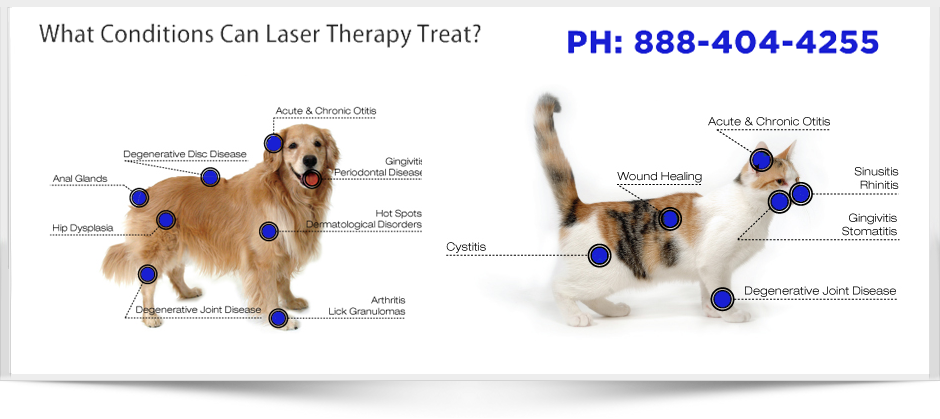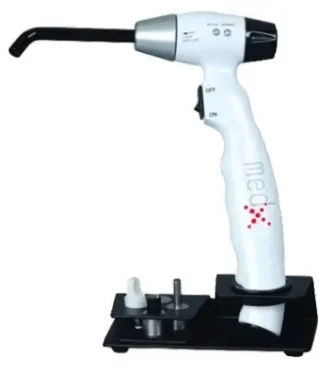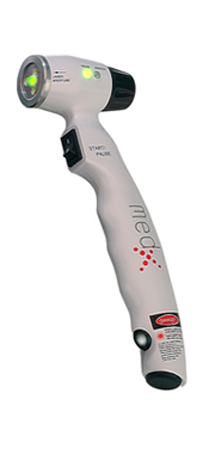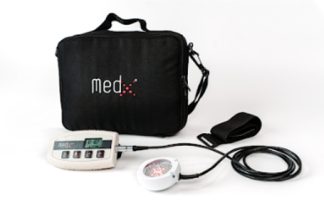
What conditions can be treated?
- Ulcerations and open wounds
- Muscle, ligament and tendon injuries
- Sprains and strains
- Pododermatitis
- Post-surgical and soft tissue trauma
- Back pain
- Neuromuscular disease
- Acute and Chronic Ear Infections
- Gingivitis
- Hot Spots
- Arthritis
- Lick Granulomas
- Degenerative Disc Disease
- Degenerative Joint Disease
- Hip Dysplasia
- Anal Gland Infections
Where is it beneficial?
Clinical studies and trials of laser therapy technology indicate the following beneficial effects of laser light therapy on tissues and cells:
Accelerated Tissue Repair and Cell Growth.
Photons of light from lasers penetrate deeply into tissue and accelerate cellular reproduction and growth. The laser light increases the energy available to the cell so that the cell can take on nutrients faster and get rid of waste products. As a result of exposure to laser light, the cells of tendons, ligaments and muscles are repaired faster.
Faster Wound Healing.
Laser light stimulates fibroblast development fibroblasts are the building blocks of collagen, which is predominant in wound healing] in damaged tissue. Collagen is the essential protein required to replace old tissue or to repair tissue injuries. As a result, laser therapy is effective on open wounds and burns.
Reduced Fibrous Tissue Formation.
Laser therapy reduces the formation of scar tissue following tissue damage from cuts, scratches, burns or surgery.
Anti-Inflammation.
Laser light therapy has an anti-edemic effect as it causes vasodilation, but also because it activates the lymphatic drainage system [drains swollen areas]. As a result, there is a reduction in swelling caused by bruising or inflammation.
Anti-Pain [Analgesic].
Laser therapy has a high beneficial effect on nerve cells which block pain transmitted by these cells to the brain and which decreases nerve sensitivity. Also, due to less inflammation, there is less edema and less pain. Another pain blocking mechanism involves the production of high levels of pain killing chemicals such as endorphins from the brain.
Improved Vascular Activity.
Laser light will significantly increase the formation of new capillaries in damaged tissue that speeds up the healing process, closes wounds quickly and reduces scar tissue. Additional benefits include acceleration of angiogenesis, which causes temporary vasodilatation, an increase in the diameter of blood vessels.
Increased Metabolic Activity.
Laser therapy creates higher outputs of specific enzymes, greater oxygen and food particle loads for blood cells.
Improved Nerve Function.
Slow recovery of nerve functions in damaged tissue can result in numbness and impaired limbs. Laser light will speed up the process of nerve cell reconnection and increase the amplitude of action potentials to optimize muscle action.
Immunoregulation.
Laser light has a direct effect on immunity status by stimulation of immunoglobulins and lymphocytes. Laser therapy is absorbed by chromophones that react to laser light. The enzyme flavomononucleotide is activated and starts the production of ATP [adenosine-tri-phosphate], which is the major carrier of cell energy and the energy source for all chemical reactions in the cells.
Trigger Points and Acupuncture Points.
Laser therapy stimulates muscle trigger points and acupuncture points on a non-invasive basis providing musculoskeletal pain relief.
When the Drugs Don’t Work
Anti-inflammatory drugs do not heal, they can not be used before a competition and they often have side effects. We believe that our Cold laser therapy should replace NSAIDS as the first treatment for equine injuries. Cold Laser can be applied by vets, owners, riders and trainers and is best delivered as soon as an injury occurs.
MD’s and scientists have now published over 1,000 laboratory and clinical trials (RCT’s) in medical journals now proving that not only can cold lasers heal soft and hard tissue, but they can also offer pain relief and rapidly resolve inflammation without side effects of drug therapies and for less cost.
What is it?
Laser and LED beams of light can stimulate the cells in the body that repair tissue, reduce inflammation and transmit pain.
How LLLT / Cold Laser Therapy Works
Certain wavelengths of light can stimulate or inhibit cellular function according to it’s intensity and the time applied.
Lasers and LED’s produce intense beams of light at specific wavelengths. When the right wavelength at the right intensity is used at the correct anatomical location for the right amount of time you can stimulate repair, resolve inflammation and reduce pain.
One of the primary mechanisms is the effect of light on cytochrome c oxidase and the consequently the unbinding of nitric oxide and release of ATP leading to improved cellular function. For anti-inflammatory effects we have found a measurable reduction in PGE2, TNF Alpha and IL-6 in the synovia surrounding damaged tendons and for analgesia high intensity lasers over nerve supply can inhibit fast axonal flow.
In addition, high intensity single point lasers can release trigger points and treat acupuncture points instead of needles.
3B or Class IV Lasers? What’s the difference?
Class IV lasers are stronger than 3B but they do not work as well because they can over treat tissue. Just like any medicine an overdose can be a bad thing.
Class IV beams need to be defocused so that they do not cut tissue, and so they work in the same fashion as 3B lasers, but even so the beams are still a bit too strong and do not work so well. Scientific evidence confirms that lower intensity is more effective for inflammation and healing.
MedX Laser Therapy Systems:
-
 Medx Dental Console System with Laser and SLD Clusters.$4,695.00
Medx Dental Console System with Laser and SLD Clusters.$4,695.00 -
 MedX Oralase$3,495.00
MedX Oralase$3,495.00 -
Product on sale
 Medx Oralase Portable Cold LaserOriginal price was: $3,995.00.$3,495.00Current price is: $3,495.00.
Medx Oralase Portable Cold LaserOriginal price was: $3,995.00.$3,495.00Current price is: $3,495.00. -
 Medx Oralase Portable Cold Laser$3,495.00
Medx Oralase Portable Cold Laser$3,495.00 -
 MedX Rehab Laser (Portable), Carrying Case and Power Supply.$1,995.00
MedX Rehab Laser (Portable), Carrying Case and Power Supply.$1,995.00 -
 MedX Home Laser Unit W/ SLD Cluster$1,495.00
MedX Home Laser Unit W/ SLD Cluster$1,495.00 -
 MedX Oralase Product Overview Video
MedX Oralase Product Overview Video
